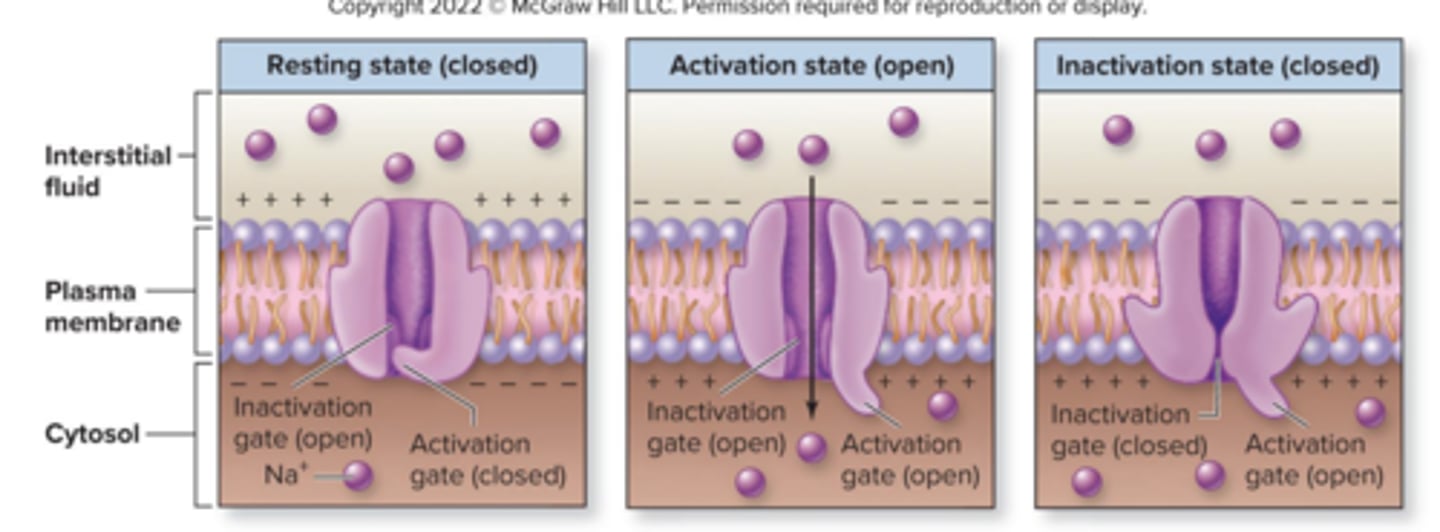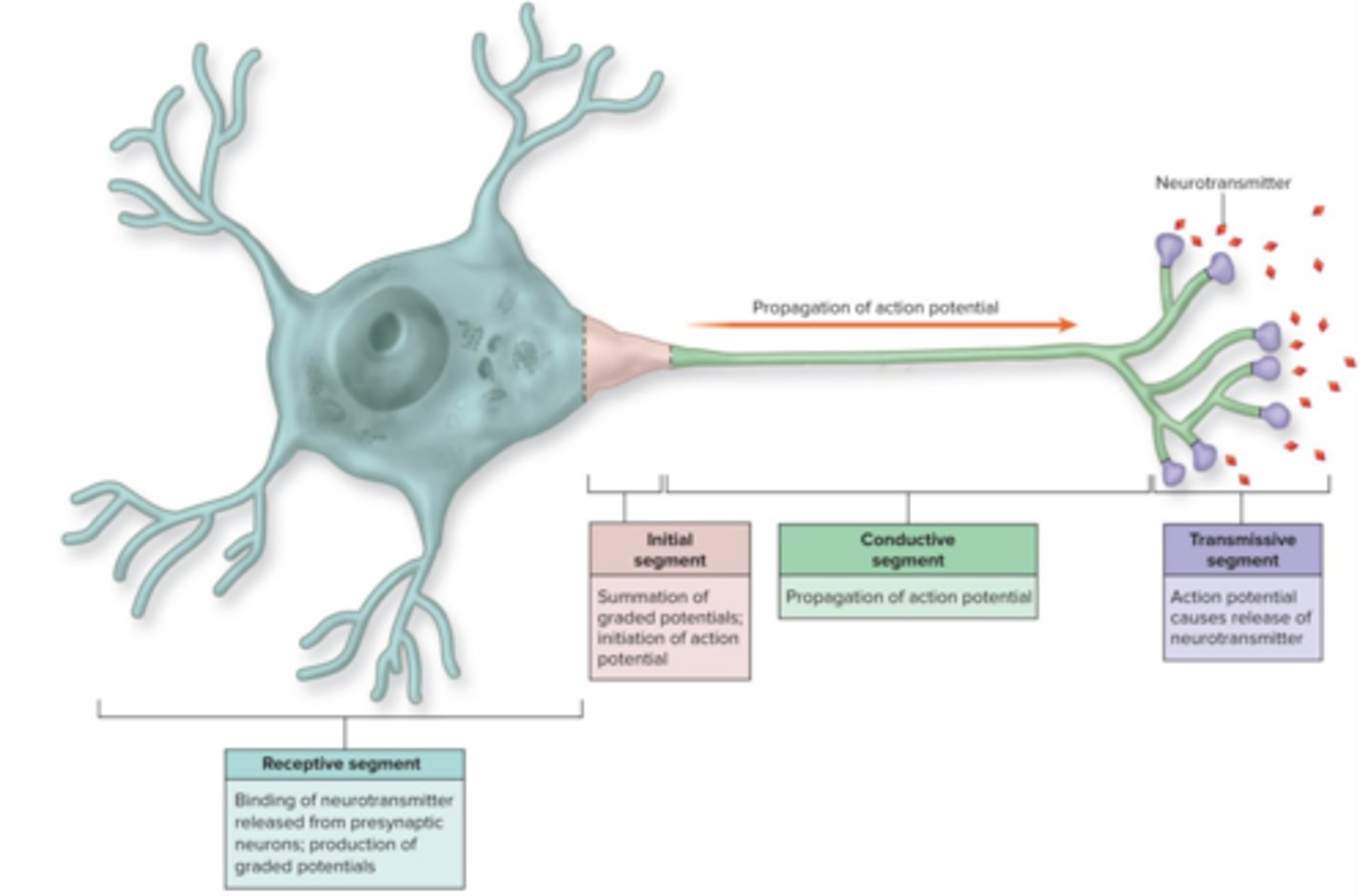ch 12: nervous tissue pt 3 - pumps & channels in neurons, brief intro to neuron potentials
1/40
There's no tags or description
Looks like no tags are added yet.
Name | Mastery | Learn | Test | Matching | Spaced |
|---|
No study sessions yet.
41 Terms
membrane proteins that MAINTAIN a concentration gradient by moving substances AGAINST their concentration gradient are called
pumps
do pumps require cellular energy?
yes
what type of pumps do neurons have in their membranes?
sodium, potassium, calcium
protein PORES in the membrane that allow ions to move DOWN their concentration gradient are called
channels
when channels, they allow...
a specific type of ion to diffuse
what are the three types of channels?
• leaky (passive)
• chemically/ligand-gated: open when neurotransmitter binds
• voltage-gated
the neuron is split into FOUR segments. name them and describe what they're made up of
receptive: dendrite & soma
initial: axon hillock
conductive: axon & its branches
transmissive: synaptic knobs
(RICT)
where are leaky channels in the neuron?
entire neuron
where are pumps in the neuron?
entire neuron: Na+/K+
transmissive: Ca2+
where are ligand-gated/chemically-gated channels in the neuron?
only receptive; K+, Cl-, cation (both Na+ and K+)
where are voltage-gated channels in the neuron?
initial: Na+ / K+
conductive: Na+ / K+
transmissive: Ca2+
what makes Na+ voltage-gated channels unique?
they have TWO gates (activation and inactivation) instead of just one
what are the three states of the Na+ voltage-gated channel?
resting: activation gate closed, inactivation gate open = Na+ can't enter
activation: both activation and inactivation gate open = Na+ moves thru channel
inactivation: activation open, inactivation closed = Na+ can't enter
* quickly returns to resting

a "modality gated channel" opens in response to?
a specific type of sensory stimulus, ex change in temp, pressure, or light
where are modality gated channels found?
in membranes of SENSORY neurons that respond to environment changes - ex, skin respond to mechanical pressure
what is the point of leak channels & Na/K pumps along the entire plasma membrane of the neuron?
to maintain resting membrane potential
at rest, neurons are at their
resting membrane potential (RMP)
what is the most important factor in setting RMP?
K+ diffusion
due to its concentration gradient, K+ diffuses ______ of the cell at rest
out
at rest, K+ diffusion out of the cell is limited by the ___________
electrical gradient, ie the pull from the negative RMP
what would happen if only K+ leaked out?
RMP would be = [K+] is at equilibrium with the electrical gradient, ie -90mV
other than K+ diffusion, what else influences RMP?
Na+ diffusion INTO the cell; makes RMP less negative, ie -70mV instead of -90mV
other than the leak channels (both Na+ and K+), what else influences RMP?
Na+/K+ bumps, which take 3 Na+ out and 2 K+ in; contributes only about -3mV
what is actual important function of the Na+/K+ pump?
maintain concentration gradient for sodium and potassium
at rest, how are ions distributed across the neuron's plasma membrane? why?
unevenly distributed, due to the action of pumps
AT REST: in the cytosol, there is a higher concentration of which ion(s)?
K+ (and Pi + proteins)
AT REST: in the interstitial fluid, there is a higher concentration of which ion(s)?
Na+, Cl-, Ca2+
the calcium concentration gradient is where?
at the synaptic knob
at rest, the gated channels in the neuron are??
closed!
the "membrane potential" is
the electrical charge across the membrane
at rest, the cytosol is _______ compared to the interstitial fluid
negative, -70mV; can be measured with microelectrodes
voltage is the
amount of difference in electrical charge
resistance electrically is
opposition to movement of charged particles
current is
the movement of charged particles across the plasma membrane thru open channels
ohm's law
current = voltage/resistance
what is an action potential?
ALL-OR-NOTHING nerve impulse after graded potential gets us to the threshold
give a VERY BRIEF summary of what happens in the receptive segment
the neurotransmitter released by presynaptic neuron binds here; graded potentials are produced
give a VERY BRIEF summary of what happens in the initial segment
summation of graded potentials & initiation of action potential
give a VERY BRIEF summary of what happens in the conductive segment
propagation of the action potential
give a VERY BRIEF summary of what happens in the transmissive segment
action potential causes the release of neurotransmitter
image of neuron segments
